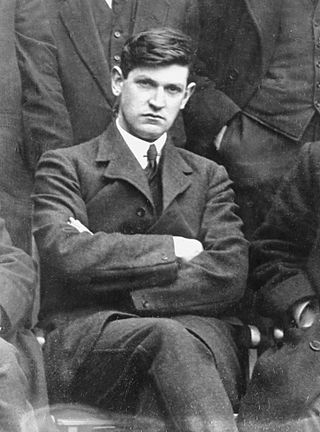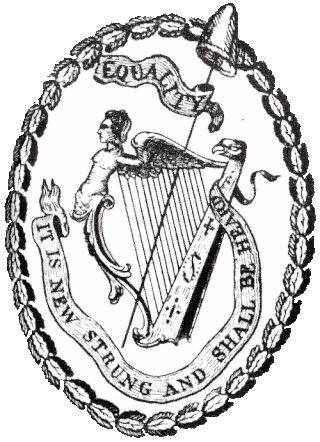
Leinster is one of the four provinces of Ireland, in the southeast of Ireland.

Michael Collins was an Irish revolutionary, soldier and politician who was a leading figure in the early-20th century struggle for Irish independence. During the War of Independence he was Director of Intelligence of the Irish Republican Army (IRA) and a government minister of the self-declared Irish Republic. He was then Chairman of the Provisional Government of the Irish Free State from January 1922 and commander-in-chief of the National Army from July until his death in an ambush in August 1922, during the Civil War.

Dublin Castle is a major Irish government complex, conference centre, and tourist attraction. It is located off Dame Street in central Dublin.

Douglas Ross Hyde, known as An Craoibhín Aoibhinn, was an Irish academic, linguist, scholar of the Irish language, politician, and diplomat who served as the first President of Ireland from June 1938 to June 1945. He was a leading figure in the Gaelic revival, and the first President of the Gaelic League, one of the most influential cultural organisations in Ireland at the time.

The Four Courts is Ireland's most prominent courts building, located on Inns Quay in Dublin. The Four Courts is the principal seat of the Supreme Court, the Court of Appeal, the High Court and the Dublin Circuit Court. Until 2010 the building also housed the Central Criminal Court; this is now located in the Criminal Courts of Justice building.

Christ Church Cathedral, more formally The Cathedral of the Holy Trinity, is the cathedral of the United Dioceses of Dublin and Glendalough and the cathedral of the ecclesiastical province of the United Provinces of Dublin and Cashel in the (Anglican) Church of Ireland. It is situated in Dublin, Ireland, and is the elder of the capital city's two medieval cathedrals, the other being St Patrick's Cathedral.
Ne Temere was a decree issued in 1907 by the Roman Catholic Congregation of the Council regulating the canon law of the Church regarding marriage for practising Catholics. It is named for its opening words, which literally mean "lest rashly" in Latin.

The Society of United Irishmen was a sworn association in the Kingdom of Ireland formed in the wake of the French Revolution to secure "an equal representation of all the people" in a national government. Despairing of constitutional reform, and in defiance both of British Crown forces and of Irish sectarian division, in 1798 the United Irishmen instigated a republican rebellion. Their suppression was a prelude to the abolition of the Irish Parliament in Dublin and to Ireland's incorporation in a United Kingdom with Great Britain. An attempt, following the Acts of Union, to revive the movement and renew the insurrection led to an abortive rising in Dublin in 1803.

Drumcondra is a residential area and inner suburb on the Northside of Dublin, Ireland. It is administered by Dublin City Council. The River Tolka and the Royal Canal flow through the area.

The Irish Rebellion of 1798 was a popular insurrection against the British Crown in what was then the separate, but subordinate, Kingdom of Ireland. The main organising force was the Society of United Irishmen. First formed in Belfast by Presbyterians opposed to the landed Anglican establishment, the Society, despairing of reform, sought to secure a republic through a revolutionary union with the country's Catholic majority. The grievances of a rack-rented tenantry drove recruitment.

Churchtown is a largely residential affluent suburb on the southside of Dublin, between Rathfarnham and Dundrum.
The architecture of Ireland is one of the most visible features in the Irish countryside – with remains from all eras since the Stone Age abounding. Ireland is famous for its ruined and intact Norman and Anglo-Irish castles, small whitewashed thatched cottages and Georgian urban buildings. What are unaccountably somewhat less famous are the still complete Palladian and Rococo country houses which can be favourably compared to anything similar in northern Europe, and the country's many Gothic and neo-Gothic cathedrals and buildings.
Phibsborough, also spelled Phibsboro, is a mixed commercial and residential neighbourhood on the Northside of Dublin, Ireland.
Several people are reported to have served as Chief of Staff of the Irish Republican Army in the organisations bearing that name. Due to the clandestine nature of these organisations, this list is not definitive.

Smithfield is an area on the Northside of Dublin. Its focal point is a public square, formerly an open market and common, now officially called Smithfield Plaza, but known locally as Smithfield Square or Smithfield Market. Historically, Smithfield formed the western part of Oxmantown and lay close to Oxmantown Green.

The River Poddle is a river in Dublin, Ireland, a pool of which gave the city its English language name. Boosted by a channel made by the Abbey of St. Thomas à Becket, taking water from the far larger River Dodder, the Poddle was the main source of drinking water for the city for more than 500 years, from the 1240s. The Poddle, which flows wholly within the traditional County Dublin, is one of around a hundred members of the River Liffey system, and one of over 135 watercourses in the county; it has just one significant natural tributary, the Commons Water from Crumlin.

Talbot Street is a city-centre street located on Dublin's Northside, near to Dublin Connolly railway station. It was laid out in the 1840s and a number of 19th-century buildings still survive. The Irish Life Mall is on the street.
Edel Bhreathnach is an Irish historian and academic and former CEO of the Discovery Programme.

Leixlip is a town in north-east County Kildare, Ireland. Its location on the confluence of the River Liffey and the Rye Water has marked it as a frontier town historically: on the border between the ancient kingdoms of Leinster and Brega, as an outpost of The Pale, and on Kildare's border with County Dublin. Leixlip was also a civil parish in the ancient barony of Salt North.
The Ciannachta were a population group of early historic Ireland. They claimed descent from the legendary figure Tadc mac Céin. Modern research indicates Saint Cianán and his followers may have been the origin behind the tribal name as it is a late construction similar in form to Eóganachta and Connachta. They first appear in historical sources in the 6th century, and were found in several parts of the island, including in Brega and Airgialla. The Ciannachta groups were absorbed over time. Modern descendants have formed a Clan Cian society.















